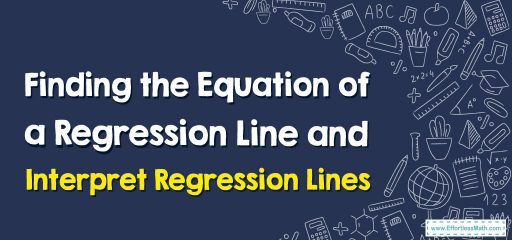How to Find the Equation of a Regression Line and Interpret Regression Lines

Finding the regression line in several steps is fully and accurately explained in this article.
Step \(1\): Collect data on the two desired variables and organize them in a scatter plot.
Step \(2\): As mentioned at the beginning of the article, the equation of the line of best fit is found using the least squares method. To find the line, you must first calculate the slope (\(m\)) and \(y\)-intercept (\(b\)). Slope and \(y\)-intercept are calculated using the following formulas:
\(m=\frac{(nΣ(xy)-(Σx)(Σy))}{(nΣ(x^2)-(Σx)^2)}\)
\(b=\frac{(Σy-mΣx)}{n}\)
Step \(3\): Using the found slope and \(y\)-intercept, the equation of the regression line will be \(y=mx+b\).
Step \(4\): The slope and \(y\)-intercept of the regression line are used to interpret the line. The slope shows the amount of change in \(y\) against a unit change in \(x\) and can be interpreted as the strength and direction of the relationship between the variables. A positive slope indicates a positive relationship, while a negative slope indicates a negative relationship. The slope shows the amount of change in \(y\) against a unit change in \(x\) and can be interpreted as the strength and direction of the relationship between the variables. A positive slope indicates a positive relationship, while a negative slope indicates a negative relationship. The \(y\)-intercept represents the value of \(y\) when \(x=0\) and represents the intersection of the line with the \(y\)-axis.
Step \(5\): The correlation coefficient (\(r\)) is used to measure the strength and direction of the linear relationship between two variables. A correlation coefficient of \(+1\) indicates a complete positive linear relationship, a coefficient of \(-1\) indicates a complete negative linear relationship, and a coefficient of \(0\) indicates the absence of a linear relationship. You can use the correlation coefficient for interpretation.
Step \(6\): To interpret the regression line, you can also use the coefficient of determination (\(R^2\)), which indicates the ratio of changes in the dependent variable that is explained by the independent variable. \(R^2\) is always between \(0\) and \(1\), and the closer \(R^2\) is to \(1\), the better the model explains the data.
A regression line is only an approximation of the relationship between variables and may not accurately describe the relationship for values of \(x\) that are outside the range of the data.
Related to This Article
More math articles
- 5th Grade IAR Math FREE Sample Practice Questions
- The Ultimate TABE Math Course (+FREE Worksheets & Tests)
- How to Solve Word Problems by Adding Three or More Decimals
- How to Interpret STAAR Scores?
- How to Prepare for the CLEP College Mathematics Test?
- 4th Grade FSA Math Practice Test Questions
- 4th Grade NYSE Math Worksheets: FREE & Printable
- Top 10 7th Grade Common Core Math Practice Questions
- Number Properties Puzzle -Critical Thinking 3
- How to Find the x-Intercept of a Line?






































What people say about "How to Find the Equation of a Regression Line and Interpret Regression Lines - Effortless Math: We Help Students Learn to LOVE Mathematics"?
No one replied yet.